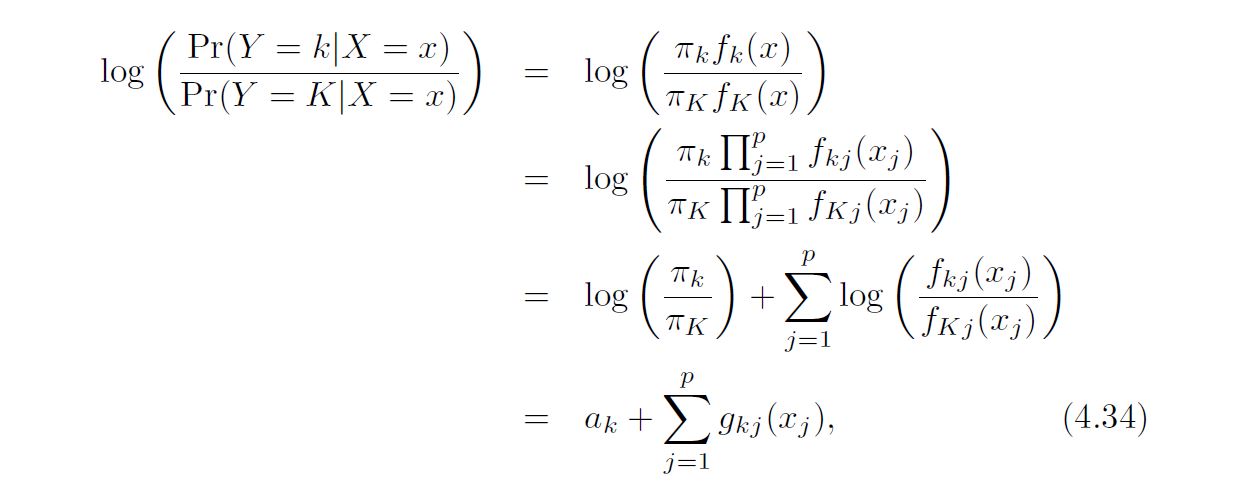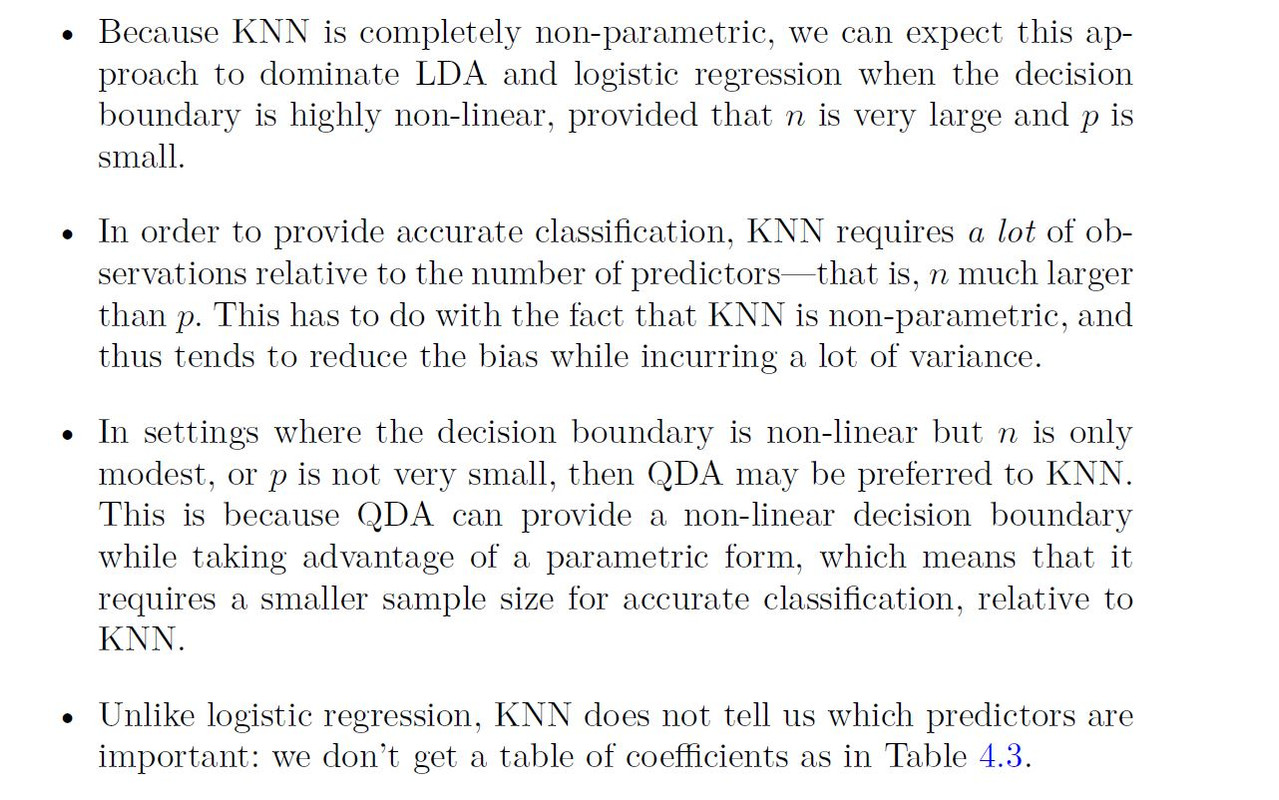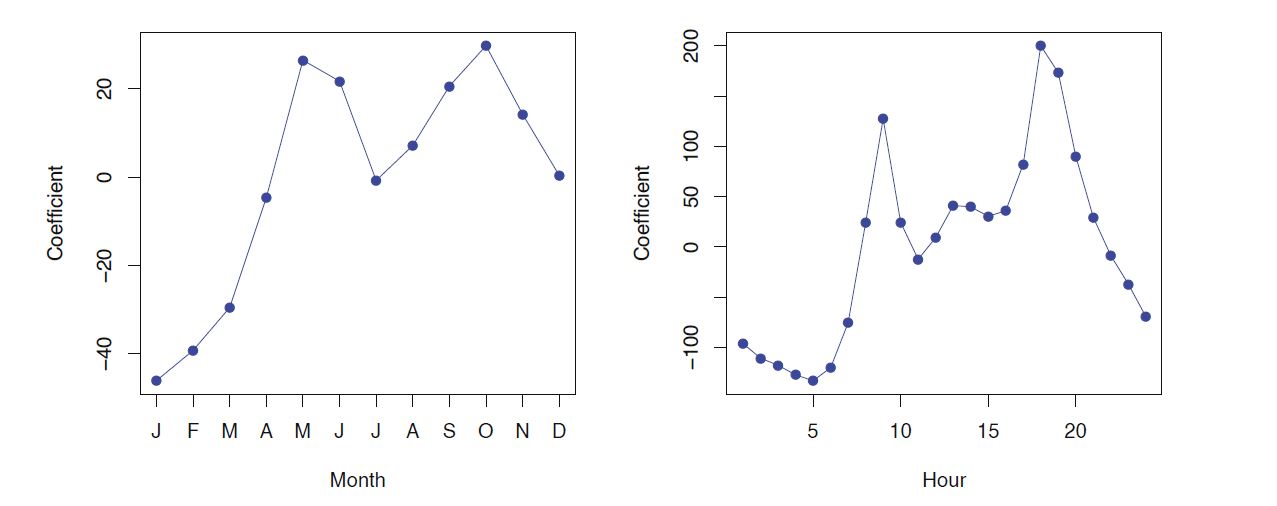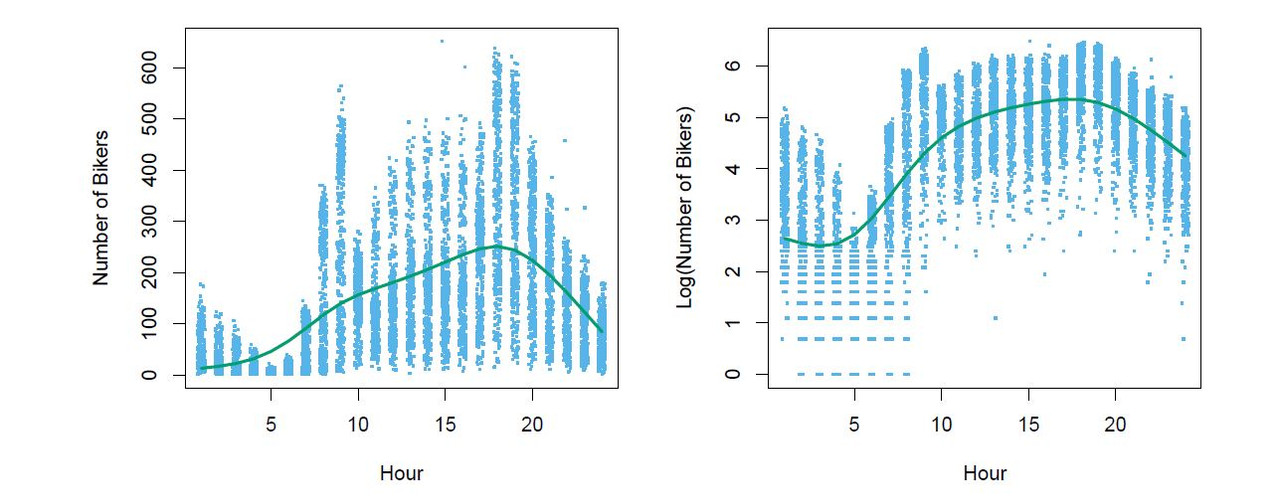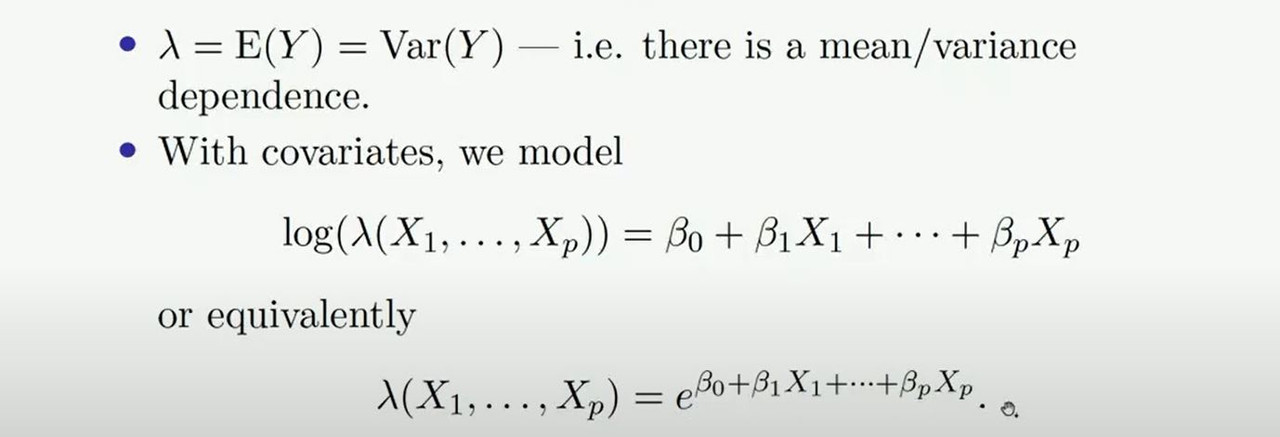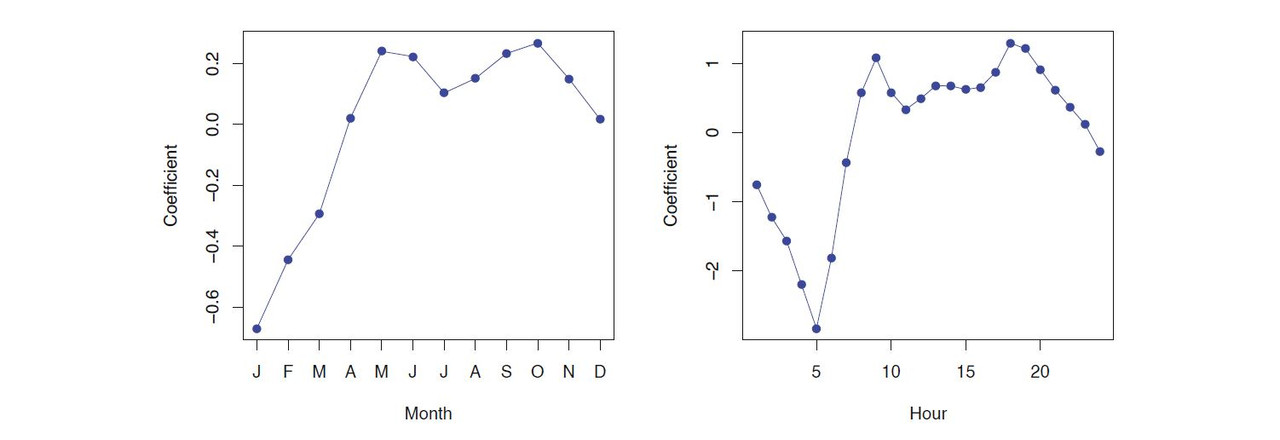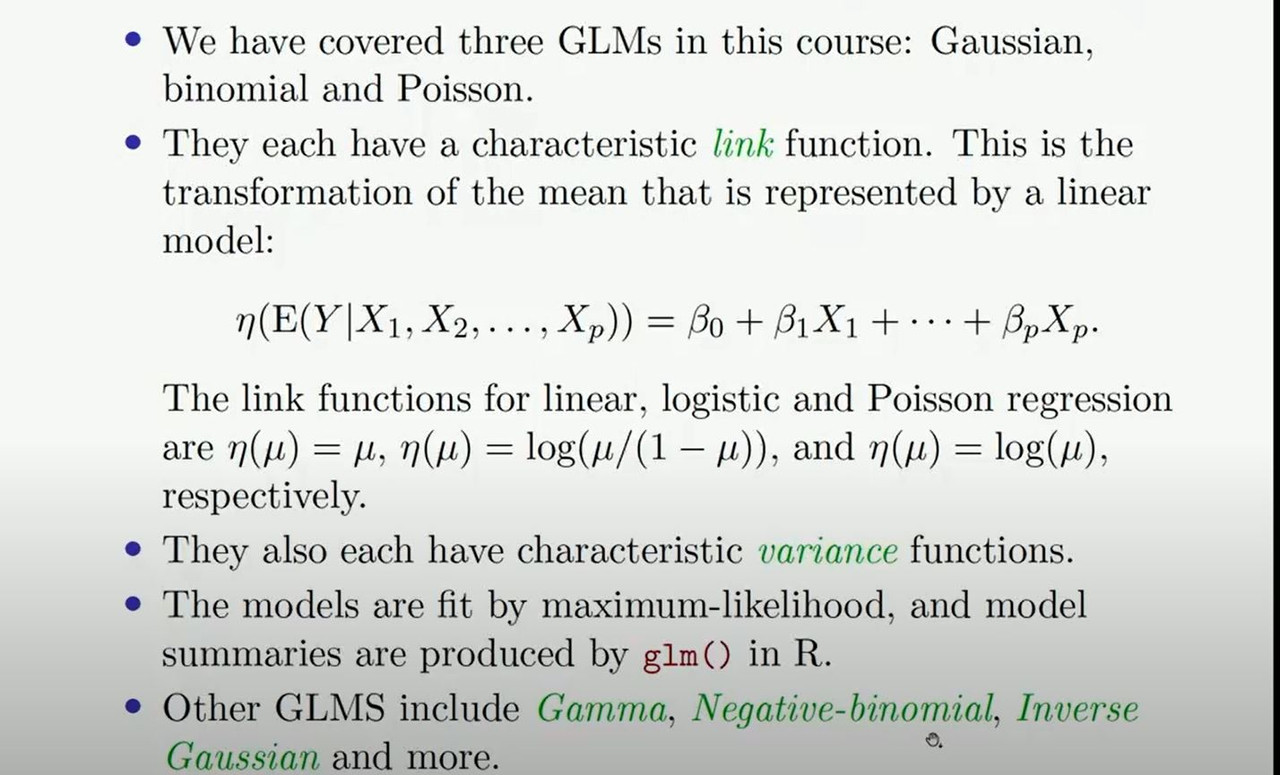Table of Content
4. Classification
------------------------------------------------------------------------
4.1 An Overview of Classification.
------------------------------------------------------------------------
Classification problems occur often, perhaps even more so than regression problems for Example:
A person arrives at the emergency room with a set of symptoms that could possibly be attributed to one of three medical conditions. Which of the three conditions does the individual have?
An online banking service must be able to determine whether or not a transaction being performed on the site is fraudulent, on the based of the user’s IP address, past transaction history, and so forth.
On the basis of DNA sequence data for a number of patients with and without a given disease, a biologist would like to figure out which DNA mutations are deleterious (disease-causing) and which are n
------------------------------------------------------------------------
4.2 Why Not Linear Regression?
------------------------------------------------------------------------
We have stated that linear regression is not appropriate in the case of a qualitative response. Why not? Suppose that we are trying to predict the medical condition of a patient in the emergency room on the basis of her symptoms. In this simplified example, there are three possible diagnoses: stroke, drug overdose, and epileptic seizure. We could consider encoding these values as aquantitative response variable,Y as follows:
Using this coding, least squares could be used to ft a linear regression model to predict Y on the basis of a set of predictors X1,...,Xp. Unfortunately, this coding implies an ordering on the outcomes, putting drug overdose in between stroke and epileptic seizure, and insisting that the difference between stroke and drug overdose is the same as the difference between drug overdose and epileptic seizure. In practice there is no particular reason that this needs to be the case. For instance, one could choose an equally reasonable coding
which would imply a totally different relationship among the three conditions. Each of these coding would produce fundamentally different linear models that would ultimately lead to different sets of predictions on test observations.
If the response variable’s values did take on a natural ordering, such as mild, moderate, and severe, and we felt the gap between mild and moderate was similar to the gap between moderate and severe, then a 1, 2, 3 coding would be reasonable. Unfortunately, in general there is no natural way convert a qualitative response variable with more than two levels into a quantitative response that is ready for linear regression to
------------------------------------------------------------------------
4.3 Logistic Regression
------------------------------------------------------------------------
Consider again the Default data set, where the response default falls into one of two categories, Yes or No. Rather than modeling this response Y directly, logistic regression models the probability that Y belongs to a particular category.
For the Default data, logistic regression models the probability of default. For example, the probability of default given balance can be written as
Pr(default = Yes|balance).
For example, one might predict default = Yes
for any individual for whom p(balance) > 0.5. Alternatively, if a company wishes to be conservative in predicting individuals who are at risk for default, then they may choose to use a lower threshold, such as p(balance) > 0.1.
------------------------------------------------------------------------
4.3.1 The Logistic Model
------------------------------------------------------------------------
In logistic regression, we use the logistic function,
------------------------------------------------------------------------
4.3.2 Estimating the Regression Coefficients
------------------------------------------------------------------------
------------------------------------------------------------------------
4.3.4 Multiple Logistic Regression
------------------------------------------------------------------------
We now consider the problem of predicting a binary response using multiple predictors. By analogy with the extension from simple to multiple linear regression in Chapter 3, we can generalize (4.4) as follows:
Multiple Logistic Regression model results interpretation
1. Balance:
For each one-unit increase in the balance, the log-odds of the dependent variable being 1 increases by 0.0057. Since the p-value is less than 0.0001, this variable is statistically significant, indicating that balance has a significant impact on the outcome
2. Income:
For each one-unit increase in income, the log-odds of the dependent variable being 1 increases by 0.0030. However, the high p-value (0.7115) suggests that income is not statistically significant in predicting the outcome, meaning its effect could be due to chance.
3. Student [Yes]:
Being a student (Yes) decreases the log-odds of the dependent variable being 1 by 0.6468. The p-value (0.0062) indicates that this variable is statistically significant, meaning student status has a significant effect on the outcome.
Summary
(The balance and student status variables are significant predictors of the outcome.)
(Income does not appear to be a significant predictor in this model.)
(The signs of the coefficients indicate the direction of the relationship with the dependent variable: positive for balance and negative for student status.)
------------------------------------------------------------------------
4.3.5 Multinomial Logistic Regression
------------------------------------------------------------------------
We sometimes wish to classify a response variable that has more than two classes. For example, we had three categories of medical condition in the emergency room: stroke, drug overdose, epileptic seizure.
However, the logistic regression approach that we have seen in this section only allows for K = 2 classes for the response variable.
It turns out that it is possible to extend the two-class logistic regression approach to the setting of K > 2 classes. This extension is sometimes known as multinomial logistic regression. To do this, we first select a single class to serve as the baseline; without loss of generality, we select the Kth class for this role. Then we replace the model with the following model
------------------------------------------------------------------------
4.4 Generative Models for Classification
------------------------------------------------------------------------
Logistic regression involves directly modeling Pr(Y = k|X = x) using the logistic function, . In statistical jargon, we model the conditional distribution of the response Y , given the predictor(s) X. We now consider an alternative and less direct approach to estimating these probabilities.
In this new approach, we model the distribution of the predictors X separately in each of the response classes (i.e. for each value of Y ). We then use Bayes’ theorem to fip these around into estimates for Pr(Y = k|X = x). When the distribution of X within each class is assumed to be normal, it turns out that the model is very similar in form to logistic regression
Why do we need another method, when we have logistic regression?
There are several reasons:
1. When there is substantial separation between the two classes, the
parameter estimates for the logistic regression model are surprisingly unstable. The methods that we consider in this section do not suffer from this problem.
2. If the distribution of the predictors X is approximately normal in
each of the classes and the sample size is small, then the approaches in this section may be more accurate than logistic regression.
3. The methods in this section can be naturally extended to the case
of more than two response classes. (In the case of more than two response classes, we can also use multinomial logistic regression from Section 4.3.5.)
Suppose that we wish to classify an observation into one of K classes, where K ≥ 2. In other words, the qualitative response variable Y can take on K possible distinct and unordered values. Let πk represent the overall or prior probability that a randomly chosen observation comes from the kth class. Let fk(X) ≡ Pr(X|Y = k)1 denote the density function of X for an observation that comes from the kth class. In other words, fk(x) is relatively large if there is a high probability that an observation in the kth class has X ≈ x, and fk(x) is small if it is very unlikely that an observation in the kth class has X ≈ x. Then Bayes’ theorem states that In accordance with our earlier notation, we will use the abbreviation pk(x) = Pr(Y = k|X = x); this is the posterior probability that an observation X = x belongs to the kth class. That is, it is the probability that the observation belongs to the kth class, given the predictor value for that observation
------------------------------------------------------------------------
4.4.1 Linear Discriminant Analysis for p = 1
------------------------------------------------------------------------
The Gaussian density has the form
Here $\mu_{k}$ is the mean and $\sigma_{k}^2$ the variance (in class k). We will assume that all the $\sigma^2$ = $\sigma$ are the same
Plugging this into Bayes formula, we get a rather complex expression of pk(x) = Pr(y=k | X=x)
------------------------------------------------------------------------
4.4.2 Linear Discriminant Analysis for p >1
------------------------------------------------------------------------
We now extend the LDA classifier to the case of multiple predictors. To do this, we will assume that X = (X1, X2,...,Xp) is drawn from a multivariate Gaussian (or multivariate normal) distribution, with a class-specific mean vector and a common covariance matrix. We begin with a brief review of this distribution
In the case of p > 1 predictors, the LDA classifier assumes that the observations in the kth class are drawn from a multivariate Gaussian distribution N(µk, Σ), where µk is a class-specific mean vector, and Σ is a covariance matrix that is common to all K classes. Plugging the density function for the kth class, fk(X = x), into (4.15) and performing a little bit of algebra reveals that the Bayes classifier assigns an observation X to the class for which = x
Result (confusion matrix)
ROC
The ROC curve is a popular graphic for simultaneously displaying the ROC curve two types of errors for all possible thresholds. The name “ROC” is historic, and comes from communications theory. It is an acronym for receiver operating characteristics. Figure 4.8 displays the ROC curve for the LDA classifier on the training data. The overall performance of a classifier, summarized over all possible thresholds, is given by the area under the (ROC) curve (AUC). An ideal ROC curve will hug the top left corner, so the larger the AUC the better the classifier. For this data the AUC is 0.95, which is close to the maximum of 1.0, so would be considered very good. We expect a classifier that performs no better than chance to have an AUC of 0.5 (when evaluated on an independent test set not used in model training). ROC curves are useful for comparing different classifiers, since they take into account all possible thresholds. It turns out that the ROC curve for the logistic regression model of Section 4.3.4 ft to these data is virtually indistinguishable from this one for the LDA model, so we do not display it here.
A ROC curve for the LDA classifier on the Default data. It traces out two types of error as we vary the threshold value for the posterior probability of default. The actual thresholds are not shown. The true positive rate is the sensitivity: the fraction of defaulters that are correctly identified, using a given threshold value. The false positive rate is 1-specifcity: the fraction of non-defaulters that we classify incorrectly as defaulters, using that same threshold value. The ideal ROC curve hugs the top left corner, indicating a high true positive rate and a low false positive rate. The dotted line represents the “no information” classifier; this is what we would expect if student status and credit card balance are not associated with probability of default.
------------------------------------------------------------------------
4.4.3 Quadratic Discriminant Analysis
------------------------------------------------------------------------
As we have discussed, LDA assumes that the observations within each class are drawn from a multivariate Gaussian distribution with a class-specifc mean vector and a covariance matrix that is common to all K classes. Quadratic discriminant analysis (QDA) provides an alternative approach Like LDA, the QDA classifier results from assuming that the observations from each class are drawn from a Gaussian distribution, and plugging estimates for the parameters into Bayes’ theorem in order to perform prediction. However, unlike LDA, QDA assumes that each class has its own covariance matrix. That is, it assumes that an observation from the kth class is of the form X ∼ N(µk, Σk), where Σk is a covariance matrix for the kth class. Under this assumption, the Bayes classifer assigns an observation X = x to the class for which is largest
As we have discussed, LDA assumes that the observations within each class are drawn from a multivariate Gaussian distribution with a class-specific mean vector and a covariance matrix that is common to all K classes. Quadratic discriminant analysis (QDA) provides an alternative approach Like LDA, the QDA classifier results from assuming that the observations from each class are drawn from a Gaussian distribution, and plugging estimates for the parameters into Bayes’ theorem in order to perform prediction. However, unlike LDA, QDA assumes that each class has its own covariance matrix. That is, it assumes that an observation from the kth class is of the form X ∼ N(µk, Σk), where Σk is a covariance matrix for the kth class. Under this assumption, the Bayes classifier assigns an observation X = x to the class is largest for which
------------------------------------------------------------------------
4.4.4 Naïve Bayes
------------------------------------------------------------------------
In previous sections, we used Bayes’ theorem to develop the LDA and QDA classifiers. Here, we use Bayes’ theorem to motivate the popular naïve Bayes classifier.
Recall that Bayes’ theorem provides an expression for the posterior probability pk(x) = Pr(Y = k|X = x) in terms of π1 .......... πk and f1(x) ..... fk(x). To use in practice, we need estimates for π1 .......... πk and f1(x) ..... fk(x). As we saw in previous sections, estimating the prior probabilities π1 .......... πk To use in practice, we need estimates for π1 .......... πk is typically straightforward: for instance, we can estimate ˆ&k as the proportion.
The naïve Bayes classifier takes a different tack for estimating f1(x), . . . , fK(x). Instead of assuming that these functions belong to a particular family of distributions (e.g. multivariate normal), we instead make a single assumption:
Within the kth class, the p predictors are independent.
Stated mathematically, this assumption means that for k = 1, . . . ,K,
$$f_{k}(x) = f_{k1}(x1) × f_{k2}(x2) × · · · × f_{kp}(xp),$$

























